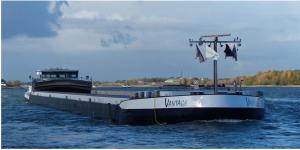Otto Klinkenberg is an inland shipping entrepreneur who has sailed on a variety of ships since 1980. He has always set great store by greening, and has seen many changes in the past 40 years. In 2007, we started to run on EN950 fuel, a cleaner, low-sulphur diesel that all shipping subsequently switched over to on 1 January 2011.”
Through CLINSH, Klinkenberg is now switching over to GTL (Gas to Liquid), a liquid fuel based on natural gas. GTL burns more cleanly than conventional diesel, with fewer local emissions and less visible black smoke. He has chosen to participate in CLINSH to demonstrate that using GTL is actually a cleaner option. “This data will help to convince more inland skippers.”
Costs and benefits
“GTL is more expensive than conventional diesel, which for many inland skippers means it’s a question of costs versus benefits. Everyone wants to introduce greener processes to their work, but no one wants to pay for them. If GTL were used by more skippers, it would become cheaper automatically. If we can then demonstrate without any doubt that using GTL is actually cleaner, we’d be able to convince more people.”
Klinkenberg has only recently started working with CLINSH. The equipment has now been installed and a baseline measurement is being carried out of the use of conventional gas oil. Once these measurements are complete, the switch to GTL will follow. These measurements will allow comparison between gas oil and GTL. Klinkenberg anticipates that the exhaust fume measurements will make the difference. “GTL has a couple of other benefits too — the engine is cleaner and it makes less noise.”
CCR2 standard
Klinkenberg continues to operate an older CCR1 engine, while CCR2 engines are now the standard. Starting next year, all engines will be expected to comply with stage five standards. “A stage five certificate cannot be obtained with older engines, even if the engine’s emissions do satisfy the standard.” For Klinkenberg, however, the transition to GTL means that he does not need to invest in a new engine.
Shared responsibility
Are there any other low-treshold measures that can help to reduce emissions from inland shipping? "It can only really be done with GTL. Otherwise, you have to start using catalytic converters and then you’d be faced with huge investment costs (at least €100,000 a year, ed.). Urea costs a lot of money and that’s a real barrier as operation then becomes more expensive. People will not freely invest in that, that’s something you need the government for,” explains Klinkenberg. “At some point in time, we will need to look at all of the options. In terms of the amount, GTL is fairly low-threshold, but some people just don’t have anything left with which to invest.”
How much does the transition to GTL cost then? “Our ship is pretty big, which means that the operational costs for the transition to GTL are between €20,000 and €30,000 a year. Thus far, the investment has only cost money. You do get a discount on port fees, but that’s peanuts when considered on an annual basis. When you’re making investments like this, unfortunately you can no longer be the cheapest. The business community needs to be forced by the government to respond. Greening is not always the best way to run a business. There needs to be a push, or customers need to be prepared to pay more. At the moment, people unfortunately still opt for the cheapest quote. If the entire chain is prepared to pay for it, then individual investments can be reduced to just small amounts.”
The future of inland shipping
Klinkenberg is clear on the future, “We need to skip a step.” Switching to hybrids is a costly investment and other options will certainly be available in the future. These are still in the early stages though. Klinkenberg believes that in twenty years' time, everything will be run on hydrogen and electricity. “It’s still a long way off, but sometimes things move quicker than you think. Hydrogen is not yet harmless (explosive under extreme pressure, ed.), but H2fuel is on the agenda — that’s hydrogen in powdered form that can be mixed with a water-based substance. That’s the future.”
Klinkenberg concludes by pointing out that we need to look at things from a positive angle. “Of course, we need to continue to improve, but if you look back at the steam era, ships have become so much cleaner. Every little step helps.”

